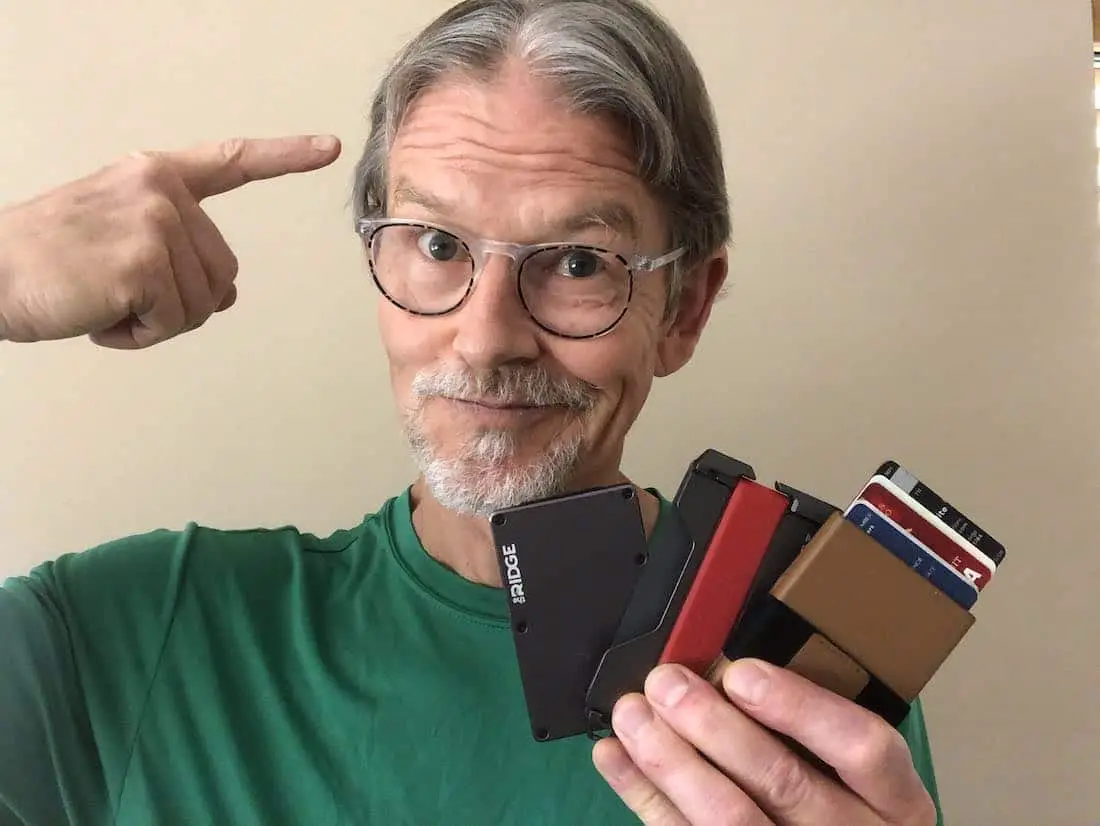An innovative wallet has technical or design enhancements that go beyond the plain old leather billfold. It might block unauthorized RFID scans, contain a tracking device, have a built-in mechanism to eject credit cards, or made to be practically indestructible.
A wallet can be called innovative because of its minimalist size. If it keeps your cards from bending or breaking, that’s pretty smart, too. Add GPS and Bluetooth location technology and a wallet’s IQ goes through the roof.
A wallet that opens a beer? Yes, it’s also using higher tech than your typical lump of pocket leather. And so is a “magic” wallet that seems to defy the laws of physics.
What it’s NOT, by the way, is a wallet that has anything at all to do with cryptocurrency or electronic banking. The wallets that I discuss in this post are all about the physical kind that you carry in your pocket.
Minimalist
The less cards and cash you carry, the less you have to manage on a day-to-day basis. “Only carry what you need,” is the minimalist’s credo.
When wallets get this small, they are usually referred to as card holder wallets, or simply card holders. In fact, many minimalist wallets are no larger than the credit cards they carry inside.
A good example of this is the Ridge card holder. It is basically a sandwich of rigid plates held together with stout elastic bands. It holds up to 12 cards firmly between the plates.
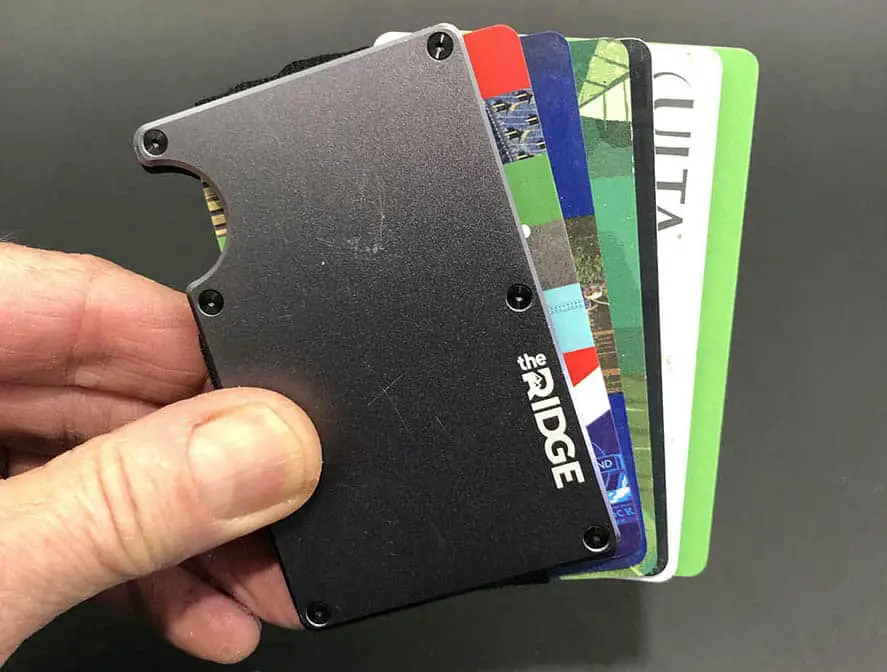
By design, a minimalist wallet or cardholder doesn’t take up much real estate in your pocket. It generally has a money clip or money band that holds a few bills of cash. Some wallets expand in thickness as you add cards (like the Ridge). Others, (like the Ekster Parliament), have a rigid aluminum case that will only hold a half dozen cards.
Related: Here are some of the best minimalist wallets for 2020.
The decision to carry a minimalist wallet is as much philosophical as it is pragmatic. First and foremost, it forces you to commit to carrying less. Soon, you’ll begin soul searching about all the other ways you can free up space in your pocket.
Get brutally honest and ask yourself:
- How many keys on my key ring have I not used in years?
- Do I need to carry extra cash that I rarely spend?
- Is my pocket knife necessary (when a wallet-ready multi-tool like the Dango MT01 does all the same things)?
- If I only use one credit 90% of the time, why do I carry 4 others?
- How many more years do I plan to continue to sit on this big lump in my hip pocket?
If your overstuffed pants’ pocket looks like a squirrel’s cheek full of nuts, it might be time to minimize your everyday carry. Slim down, lean out, and lighten your load.
Good examples of minimalist wallets:
Trackable
To many people (myself included), a full-featured wallet is not complete without technology that makes it hard to lose. Just as importantly, the same technology should help you find it. A wallet with this kind of tech goes by many names, including:
- trackable
- anti-theft
- theft-proof
- anti-lost
- GPS wallet
- Bluetooth wallet
A wallet with tracking ability works in one of two ways. Either it has the electronics built into the wallet itself, or it uses an external tracking device that is designed to fit in one of the slots or pockets of the wallet. Generally, an add-on tracking device is the same size as a credit card and 2 or 3 times as thick.
A few good examples are the Chipolo CARD (2020) and the Ekster Solar-powered tracker card.
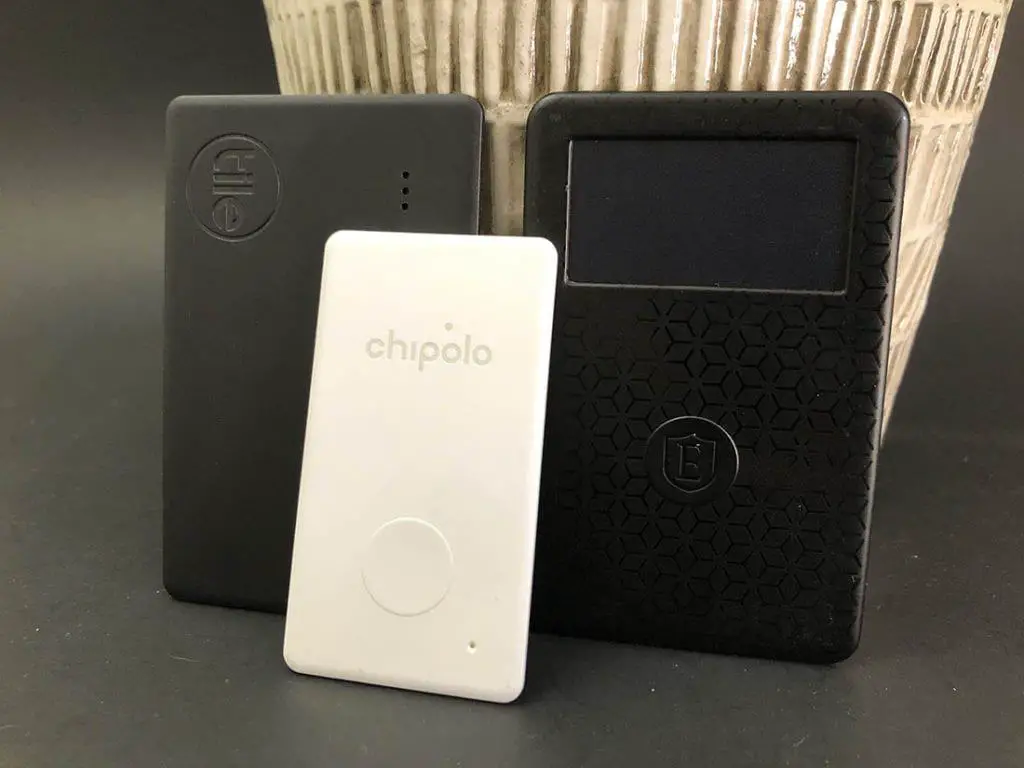
How does a tracker work?
Wallet trackers are often referred to as GPS trackers, but this is only partially true. They are really Bluetooth trackers that must connect to your smartphone wirelessly with Bluetooth through the tracker’s app in order to find your wallet. Your phone is what has GPS capability, so the tracker’s app and your phone work together to connect to the rest of the world.
As long as your phone and your wallet are within Bluetooth range (about 100-200 feet), a tracker will play a tone to find your wallet. You can also do the reverse and press a button on the tracker to find your phone. Through the tracker’s app, your phone will show your wallet tracker’s position on a map.

When you are out of Bluetooth range, however, your phone will show the last known location of your wallet. Most trackers have a feature called community find, community search, or crowd search that will help locate your wallet anywhere in the world.
The bigger the tracking network, the better
This technology uses individual phones that are part of a particular tracker’s network. When a phone with the app of the same network as yours (such as Tile or Chipolo) comes within Bluetooth range of your lost phone, it sends a message (anonymously) over the network. You’ll receive a notification and the exact GPS location of your phone.

It sounds kind of complicated, doesn’t it? But this capability is part of the app that interfaces with most built-in and external tracking cards.
RELATED: Which is better, Chipolo or Tile?
In my experience, the add-on trackers with large worldwide networks like Tile and Chipolo are much better than some of the wallets with built-in trackers. Most of the wallets with built-in trackers are upstarts from Kickstarter and Indiegogo and (as of this writing) none of them have much market penetration. That means that owner reviews are few and far between.
In general, the larger the network, the better the chance that you’ll find your wallet. So stick with the big name brands.
Good examples of Trackers:
RFID protection
RFID stands for Radio Frequency Identification. When used in credit cards, it allows contactless cards to communicate wirelessly with a merchant’s credit card reader. A wallet with RFID-blocking protection can prevent the data on these cards from being stolen.
Wallets and card holders with RFID protection either have special layers of aluminum or other metal fabrics sewn into them. Sometimes, the entire wallet is made of metal. These metals block RFID frequencies from being intercepted (skimmed) by thieves.

A majority of savvy wallets manufactured in the last 10 years incorporate this sort of protection. For some wallets, this is the only thing that makes them “smart.”
Is RFID skimming a real threat?
The dirty little secret, however, is that according to most experts, RFID data theft is a non crime. It just doesn’t happen.
Related: The threat of RFID skimming is really overblown.
Why? To start, the cards that most of use in the U.S. are contact cards, otherwise known as EMV cards. EMV stands for Europay, MasterCard, VISA.
This card has to be physically inserted into a card reader. Because there is no information sent through the air, there is nothing for an electronic thief to intercept.
Contactless cards are potentially vulnerable to RFID data theft. These cards are waved in front of credit card terminal so data is exchanged wirelessly. Only cards that have a symbol on the back that looks like a WiFi symbol lying on its side are contactless. As of 2020, most banks and credit card companies are now issuing. contactless cards.
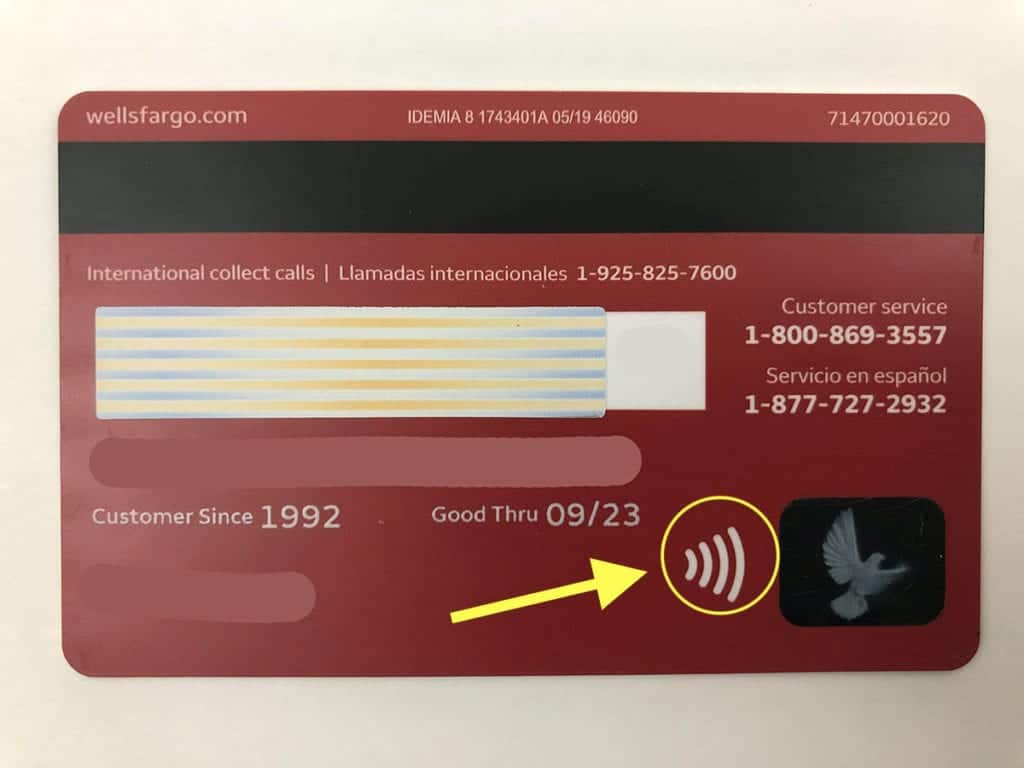
Even so, there are many technical safeguards built into contactless cards that won’t let RFID skimming happen. A run-of-the-mill pickpocket is a much greater threat to your wallet contents than the most sophisticated electronic thief.
Is it better to be safe than sorry? Most consumers apparently think so, which is why most smart wallet manufacturers continue to offer this protection in their wallets. There is no downside to purchasing an RFID-blocking wallet, so if it makes you feel better, go for it.
Good examples of RFID-blockers:
Tactical
Tactical wallets are as much tools as wallets. They have a manly vibe, usually built with a metal frame that’s often complimented by leather. These wallets appeal to outdoorsman, survivalists, first responders, and even the military.
Yet they’re city-fied enough to hold your driver’s license, credit cards, staff ID, and your rewards card to Krogers.
Multiple functions are a tactical wallet’s claim to fame. Some can cut a seat belt in an emergency, pry out a nail, or prop up your iPhone on a table for a Facetime call.
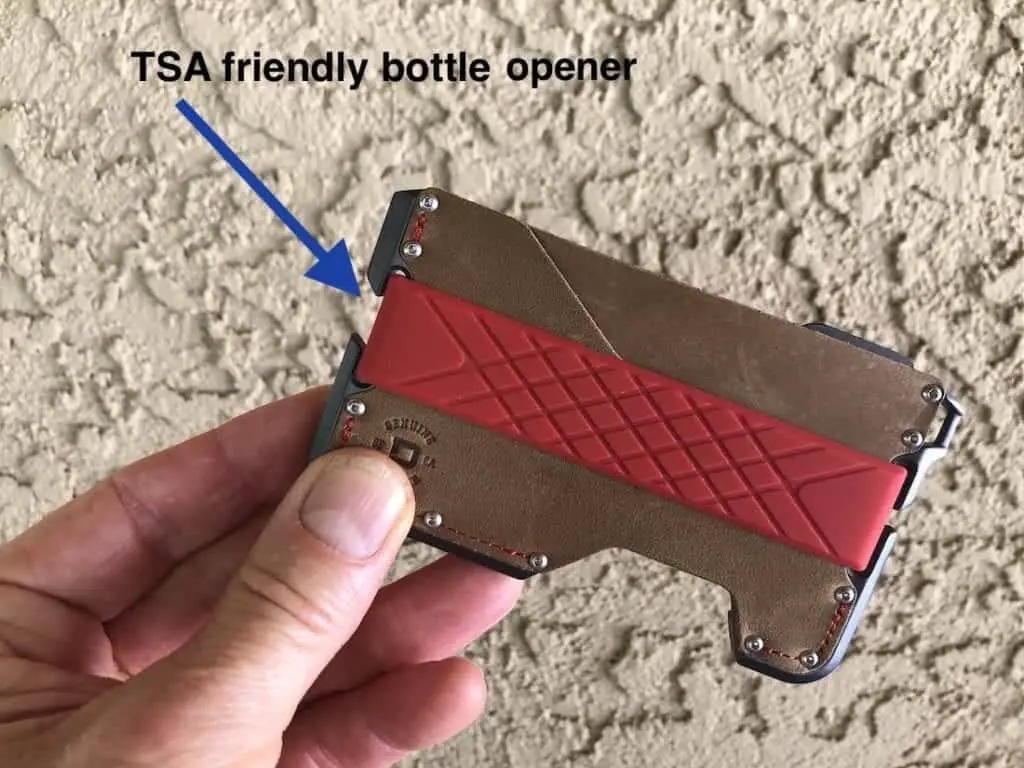
Sometimes these tools are built-in, but more often, they come from an add-on multi-tool. For instance, Dango’s MT02 clasp multi-tool is slightly larger than a credit card and only twice as thick. It has a ruler, a box cutter, and a 10mm hex wrench. Like all multi-tools, it’s designed to slide inside a Dango tactical wallet, ready to pull out when you need it.
Tactical wallets are always minimalist in size. After all, the whole idea is to incorporate as much helpful gadgetry into a tiny package that will take next to no room in your pocket. Otherwise, you may as well carry your tool box with you.
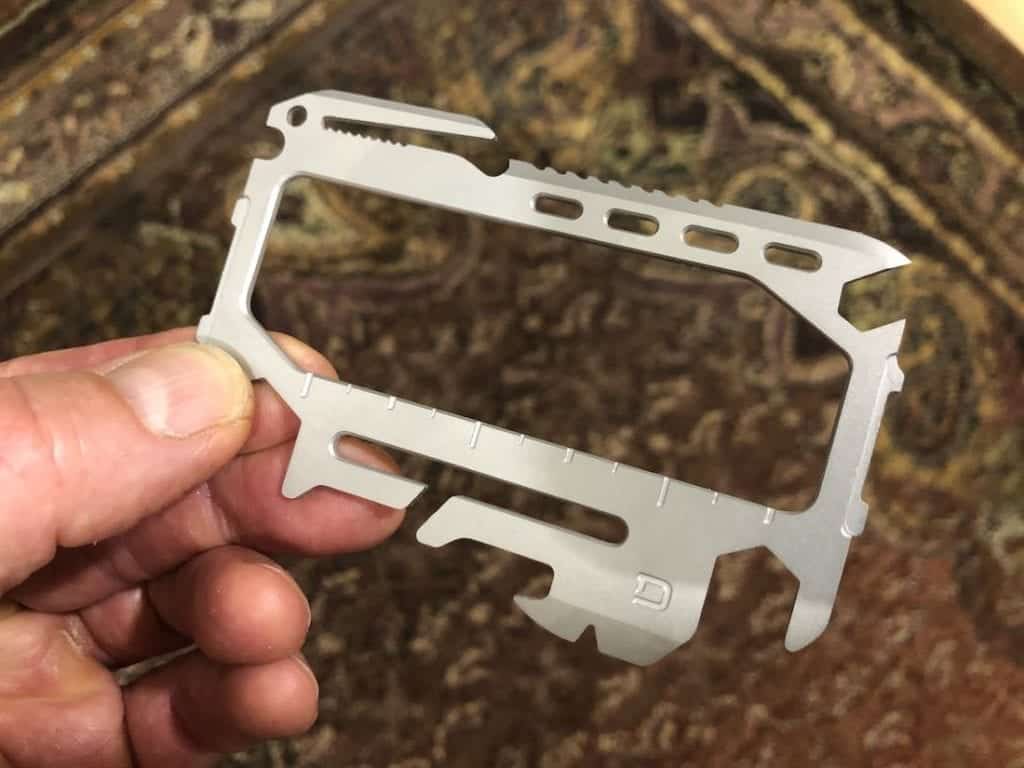
Often the metal that makes up the frame is powder-coated or anodized or heat treated. The leather is either top grain or full grain and attached with rivets that suggest indestructibility. Many have a lanyard attachment point and, of course, a money clip or money band to hold some cash.
Dango makes a line of full-blown tactical wallets, but Trayvax and others offer wallets with tactical features, too.
Good examples of Tactical wallets:
Just plain smart
Technological advances and new designs that have made wallets more brainy than ever. Here are 4 more ways to increase a wallet’s IQ.
1. Pop-up card ejector wallets
Pop-up wallets go by many different names. These are some of the variations that you often see:
- pop-up
- pop-out
- quick access
- automatic
- card ejector
- pushbutton
- slider
No matter what you call them, they all do more-or-less the same thing:
With the push of lever, slider, or button, they eject your cards out of a metal box so you can quickly choose the one you want. The best ejector wallets pop-out your cards into an evenly staggered fan so you can grab each card independently.
Related: Card ejector wallets are the cat’s meow.
The Secrid company is generally given the credit for inventing the first pop-up wallet nearly 20 years ago. Since then, the design has been mimicked and refined by others, most successfully by Ekster wallets. Both companies make their wallets in the Netherlands.
2. Quick access
Card ejector wallets generally hold up to 6 cards, less if the cards have raised letters. Most manufacturers use a rigid aluminum case to house the cards. This gives them RFID protection while housing the internal mechanism that ejects the cards.

Personally, I love this design because it gives me ultra-quick access to my cards in an instant. I often find myself pushing the button of my Ekster Senate spasmodically just to watch the cards come out. It’s a fidgeters delight.
What’s twice as cool is that with the best pop-up wallets, the cards stay inside the case until you eject them. Even if you shake the case, they stay put.
Good examples:
3. Wallets made from exotic materials
Gone is the stranglehold that leather has had on the wallet industry for a thousand years or more. Now, it’s easy to find wallets, particularly minimalist card holder wallets, made from titanium, carbon fiber, aluminum, stainless steel, and even Tyvek.
They look good while taking up much less room in your pocket. On top of that, they’re slim, light, and strong, capable of holding cards and cash alike.
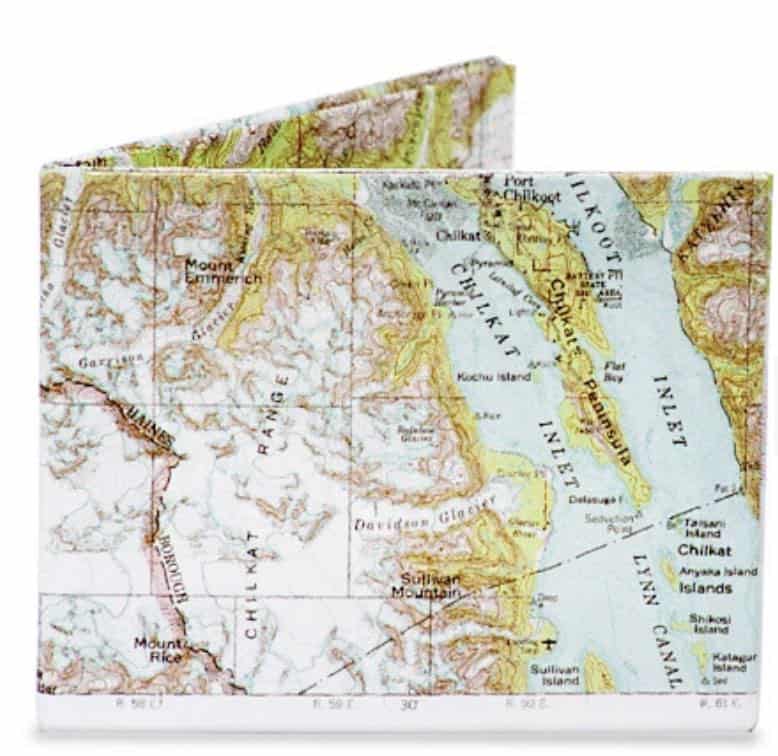
Metal wallets, particularly aluminum, provide inherent RFID protection. Tyvek wallets like the Mighty wallet are incredibly light, paper-thin, and completely tear-proof. Titanium and carbon fiber wallets are known for their high strength-to-weight ration.
There are many MANY to choose from. I’ve written dozens of post about them, so there’s a lot of information to digest if you are so inclined. Any of the following 4 will help:
- Indestructible wallets
- Metal and leather wallets
- Titanium money clip wallets
- Aluminum minimalist wallets
4. Card holder wallets with a pull strap
Card holder wallets are designed to carry credit cards, gift cards, insurance cards, and every other card that is the same size. The big question is: Once you put the cards in, how do you get them out?
You can “old school it” by removing them one by one with your fingertips. Or you can use a pull strap that will eject from 1 to a half dozen cards with a simple tug.
When you place your cards in a wallet like the Kore Slim, the cards push the strap down into the wallet, leaving the top tab of it exposed. Pull up on the strap, and whammo! You’re ready to choose the card you want.
The cards don’t come out in a perfect fan like a pop-up wallet. But the trade-off is a slimmer simpler wallet without the added complexity of a mechanism that will wear out sooner than a strap.
Good examples of wallets with a pull strap:
5. Card holder wallets with a finger notch or slot
Many minimalist card holder wallets have a sandwich-type design that holds up to a dozen cards between metal or carbon fiber plates. In order to extract the cards, you have to place one of your fingers in a notch or slot and give them a push.
The most common type by far is a C-shaped notch that is cut out of one side of the plates that make up the sandwich. This design pushes the cards out the side.

Another common design use a V-shaped notch at the bottom of the wallet and the cards are pushed out through the top.
Good examples of a wallet with a notch or slot:
Does Tile Slim work in an RFID wallet?
I tested the Tile Slim inside the RFID protected compartments of the Ridge, Ekster Slim wallet, Dango D01 Dapper, Kore Slim, and the Ekster Parliament. It rang normally inside all of these wallets. The Tile also rang when I wrapped it in a single layer of aluminum foil, but the range was reduced to a few feet.

